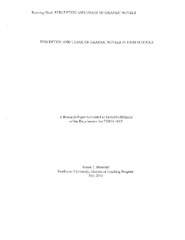Perception and Usage of Graphic Novels in High Schools
Abstract
This study sought to address the question of how teachers and librarians in a public high school perceived the instructional utility of graphic novels, and whether that perception was reflected proportionately in actual usage in classrooms. Online surveys using Likert and frequency scales were sent to teachers and librarians within a high school, seeking anonymous responses that would be analyzed quantitatively. A mistake in implementation of the survey by the researcher limited the conclusions that could be drawn from this study. No valid data about actual usage could be analyzed and a less focused sample of respondents to the survey on opinion resulted. Two strong correlations to whether a respondent categorized graphic novels as primary or supplementary material were found, however. Opinions about the degree to which graphic novels are effective tools for developing the literacy of proficient readers and perceptions of access to graphic novels were found to be strongly tied to how respondents categorized the role of graphic novels in curriculum. In order to tie these two factors, accessibility and efficacy with proficient readers, to how often graphic novels are used, more research would need to establish that categorization as primary or supplementary content is key to how often graphic novels are used. It is safe to conclude from this study, however, that perception of graphic novels as primary or supplementary texts was strongly tied to the practical concern of availability and the pedagogical opinion of whether students with well-developed reading skills benefit from inclusion of graphic novels into curriculum, within this group of respondents. Further research is needed to explore whether the perceptions and correlations found in this study are representative of the educational professionals outside of this sample.
Original item type
PDF
Original extent
v, 46 pages
Subject
Copyright
This original work is protected by copyright. Copyright is retained by the author(s). Works may be viewed, downloaded, or printed, but not reproduced or distributed without author(s) permission.


 Maintained by the Northwest University Library
Maintained by the Northwest University Library